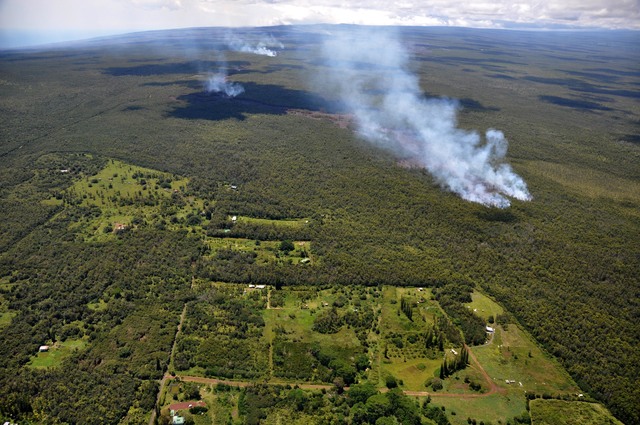From “watch” to “warning” and back: Kilauea Volcano’s status changes during past year ADVERTISING From “watch” to “warning” and back: Kilauea Volcano’s status changes during past year Last week marked the one-year anniversary of when the June 27 lava flow,
From “watch” to “warning” and back: Kilauea Volcano’s status changes during past year
Last week marked the one-year anniversary of when the June 27 lava flow, named for the date in 2014 that it began erupting from Puu Oo on Kilauea Volcano’s East Rift Zone, was considered by USGS Hawaiian Volcano Observatory scientists to be an imminent threat to Kaohe Homesteads residents in the Puna District of the Big Island.
On Sept. 4, 2014, HVO increased the USGS Volcano Alert Level for Kilauea Volcano from “watch” to “warning” as the flow advanced to within 0.7 miles of the Kaohe Homesteads boundary. Since early July, the lava flow had been advancing an average of 820 feet per day.
When the “warning” notification was issued, lava was just emerging from the third set of ground cracks that the flow had poured into along the East Rift Zone about 8 miles from Puu Oo. At the average rate of advance, HVO scientists projected that the lava flow could reach the Kaohe Homesteads within five to seven days, if it stayed within the rift zone’s ground crack system.
Instead, lava escaped the cracks and flowed along a northerly path on the west and north boundaries of Kaohe Homesteads. The flow eventually advanced another 5 miles into the middle of Pahoa town by late October, and then to the outskirts of Pahoa Marketplace in late December through March.
During this time, the flow fronts were only a few hundred yards from homes, businesses, and power and communication lines, so HVO kept the Volcano Alert Level for Kilauea at “warning.”
A series of breakouts from the lava tube system near Puu Oo early this year spawned many surface flows far upslope of Pahoa, which eventually helped to break down the tube system only 4 miles from the vent. With no lava moving through the lower part of the tube, surface flows near Pahoa Marketplace became inactive by March 13.
With the active parts of the June 27 lava flow far from inhabited areas and moving very slowly, they were no longer considered to be an immediate threat to people and property. So, HVO decreased the USGS Volcano Alert Level to “watch” on March 25, which is where it remains today.
The volcano watch and warning alert levels might sound a lot like notices issued by the National Weather Service for hazardous meteorological events, including the parade of tropical storms and hurricanes that have approached Hawaii this summer. That’s because the USGS adopted these familiar terms to create a similar standardized notification system for volcanic activity in the United States. A full description of the USGS Volcanic Activity Alert-Notification System is provided in a USGS Fact Sheet, available online at http://pubs.usgs.gov/fs/2006/3139/fs2006-3139.pdf.
This notification system was formalized in 2006 to include Volcano Alert Levels that inform people on the ground about a volcano’s status — normal, advisory, watch and warning. For Kilauea, the current “watch” level means that an eruption is occurring, but poses limited hazards to people and infrastructure on the ground. For a volcano that is not erupting, it means that the volcano is showing elevated signs of unrest with the potential of eruption increased, but not certain.
The notification system also includes an Aviation Color Code to inform the aviation industry (especially flying aircraft) about a volcano’s activity, with a particular focus on volcanic ash — green, yellow, orange and red. Kilauea’s color code today is organce, which means an eruption is underway with no, or minor, volcanic-ash emissions. Thus far, the color code has not changed from orange during the June 27 lava flow activity.
USGS volcano notifications are issued by all five U.S. volcano observatories, including HVO, based on analyses of data from monitoring networks, direct observations, and satellite-based sensors. You can receive all or some of these notifications via email by subscribing to the USGS Volcano Notification Service at http://volcanoes.usgs.gov/vns/.
Kilauea Activity Update
Kilauea’s summit lava lake level, which fluctuates in response to summit inflation and deflation, varied this past week between about 164 to 197 feet below the vent rim within Halemaumau Crater.
Kilauea’s East Rift Zone lava continues to feed widespread breakouts northeast and east of Puu Oo. All active lava remains within about 5 miles of Puu Oo. Some breakouts are evident by smoke plumes from burning vegetation where lava creeps into the forest.
No earthquakes reported felt on the Island of Hawaii during the past week.
Visit the HVO website http://hvo.wr.usgs.gov for Kilauea daily eruption updates and other volcano status reports, current volcano photos, recent earthquakes and more; call 967-8862 for a Kilauea summary update; email questions to askHVO@usgs.gov.
Volcano watch is a weekly article and activity update written by scientists at the U.S. Geological Survey‘s Hawaiian Volcano Observatory.



